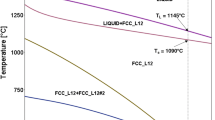Abstract
The Cu-Au-Ni braze alloys are used for metal/ceramic brazes in electronic assemblies because of their good wetting characteristics and low vapor pressure. We have studied the tensile creep properties of annealed 62Cu-35Au-3Ni alloy over the temperature range 250 °C to 750 °C. Two power-law equations have been developed for the minimum creep rate as a function of true stress and temperature. At the highest temperatures studied (650 °C and 750 °C), the minimum creep rate is well described with a stress exponent of 3.0, which can be rationalized in the context of Class I solid solution strengthening. The inverted shape of the creep curves observed at these temperatures is also consistent with Class I alloy behavior. At lower temperatures, power-law creep is well described with a stress exponent of 7.5, and normal three-stage creep curves are observed. Intergranular creep damage, along with minimum values of strain to fracture, is most apparent at 450 °C and 550 °C. The lower stress exponent in the Class I alloy regime helps to increase the strain to fracture at higher temperatures (650 °C and 750 °C). The minimum creep rate behavior of the 62Cu-35Au-3Ni alloy is also compared with those of the 74.2Cu-25. 8Au alloy and pure Cu. This comparison indicates that the 62Cu-35Au-3Ni has considerably higher creep strength than pure Cu. This fact suggests that the 62Cu-35Au-3Ni braze alloy can be used in low mismatch metal-to-ceramic braze joints such as Mo to metallized alumina ceramic with few problems. However, careful joint design may be essential for the use of this alloy in high thermal mismatch metal-to-ceramic braze joints.
Similar content being viewed by others
References
AWS Committee on Brazing and Soldering:Brazing Handbook, 4th ed., American Welding Society, Miami, FL, 1991, pp. 54–65.
H.E. Pattee: inSource Book on Brazing and Brazing Technology, M.M. Schwartz, ed., ASM, Metals Park, OH, 1980, pp. 315–57.
M.M. McDonald, D.L. Keller, and W.L. Johns: inAdvances in Welding Science and Technology, S.A. David, ed., ASM, Metals Park, OH, 1986, pp. 795–800.
J. Wittenauer: Lockheed Missiles and Space Co., Inc., Palo Alto, Ca, private communication, June 1990.
Phase Diagrams of Binary Gold Alloys, H. Okamoto and T.B. Massalski, eds., ASM INTERNATIONAL, Metals Park, OH, 1987, pp. 76–81.
R. Hultgren, P. Desai, D.T. Hawkins, M. Gleiser, and K.K. Kelley:Selected Values of the Thermodynamic Properties of Binary Alloys, ASM, Metals Park, OH, 1973, pp. 258–71.
B.D. Razuvayeva, L.A. Gutov, V.I. Syutkina, and O.D. Shashkov:Phys. Met. Metallogr., 1976, vol. 42, pp. 114–21.
R.Z. Abdulov, V.I. Syutkina, and O.D. Shashkov:Phys. Met. Metallogr., 1979, vol. 45, pp. 97–102.
B.L. Jones and CM. Sellars:Met. Sci. J., 1970, vol. 4, pp. 96–102.
W.R. Cannon and O.D. Sherby:Metall. Trans., 1970, vol. 1, pp. 1030–32.
J.J. Stephens, S.N. Burchett, and F.M. Hosking: inMetal-Ceramic Joining, P.P. Kumar and V.A. Greenhut, eds., TMS, Warrendale, PA, 1991, pp. 23–41.
Annual Book of ASTM Standards, ASTM Designation E140, ASTM, Philadelphia, PA, 1993, pp. 337–52.
J. Askill:Tracer Diffusion Data for Metals, Alloys and Simple Oxides, IFI Plenum, New York, NY, 1970, pp. 32–33.
O.D. Sherby and P.M. Burke:Prog. Mater. Sci., 1967, vol. 13, pp. 325–90.
H.W. King:J. Mater. Sci., 1966, vol. 1, pp. 79–90.
J.S. Wang and W.D. Nix:Acta Metall., 1986, vol. 34, pp. 545–55.
C.M. Sellars and A.G. Quarrell:J. Inst. Met., 1961–1962, vol. 90, pp. 329–36.
K. Monma, H. Suto, and H. Oikawa:Nippon Kinzoku Gakkaishi, 1964, vol. 28, pp. 258–63.
O.D. Sherby and M.T. Simnad:Trans. ASM, 1961, vol. 54, pp. 227–40.
J.J. Stephens and P.F. Hlava: inLow Thermal Expansion Alloys and Composites, J.J. Stephens and D.R. Frear, eds., TMS, Warrendale, PA, 1994, pp. 59–77.
Author information
Authors and Affiliations
Rights and permissions
About this article
Cite this article
Stephens, J.J., Greulich, F.A. Elevated temperature creep and fracture properties of the 62Cu-35Au-3Ni braze alloy. Metall Mater Trans A 26, 1471–1482 (1995). https://doi.org/10.1007/BF02647598
Received:
Issue Date:
DOI: https://doi.org/10.1007/BF02647598




